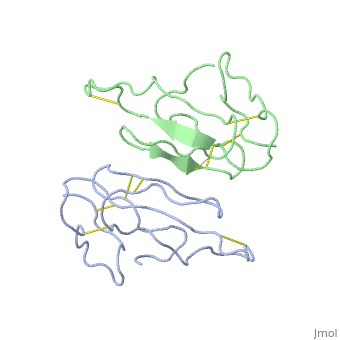Sandbox 174
|
Alpha-BungarotoxinAlpha-Bungarotoxin
Alpha-Bungarotoxin (α-BGT) is a nicotinic cholinergic antagonist that is found within the venom of Bungarus multicinctus, a South-asian snake belonging to a group commonly known as kraits. Belonging to the Elapidae Family, which consist of cobras, kraits, tiger snakes, and mambas, the venom of Bungarus multicuntus is a complex mixture of many different molecules[1] α-BGT belongs to a family of homologous proteins that act as a neurotoxic agent in the venom of these snakes. α-BGT is known to bind irreversibly to the acetylcholine receptor found at the neuromuscular junction, causing respiratory failure, paralysis, and death, as well as play an antagonstic role in binding the α7 nicotinic acetylcholine receptor in the brain.
General StructureGeneral Structure
A large amount of highly homologous snake neurotoxins have been sequenced (>60), and can be grouped into two major classes. Short neurotoxins are between 60-62 amino acids long, and consist of four
Active sites &Active sites &
FunctionsFunctions
Elapidae neurotoxins bind specifically and tightly (with a very high affinity) in a non-covalent manner to the nicotinic acetylcholine receptors in cholinergic synapses of their victims. This prevents normal neurotransmitter-induced channel opening, which in turn blocks postsynaptic membrane depolarization[1].
α7 nicotinic acetylcholine receptor bindingα7 nicotinic acetylcholine receptor binding
Reponse to sensory stimuli and seizure genesis has been linked to nicotinic mechanisms[2]. Second note to refd[3]
Seizure genesisa nd habituation of responseto sensorys timuli have been linked to nicotinic mechanisms (Marks et al., 1989;
Luntz-Leybman et al., 1992). These functions are closely associated
with the CA3 field (Schwartzkroin, 1986; Bickford-
Wimer et al., 1990). Nicotinic responsesa re mediated by two
major classeso f receptors, ganglionic type and neuromuscular
type. Pharmacological analysis of both seizure genesis and habituation
in rat brain implicates mediation by a neuromuscular
type (Miner and Collins, 1989; Luntz-Leybman et al., 1992).
These data are supported by the prominent binding of the neuromuscular-
type antagonist oc-bungarotoxin (a-BT) in the CA3
field of the hippocampus (Hunt and Schmidt, 1978; Segal et al.,
1978; Clarke et al., 1985
neuromuscular acetylcholine receptor bindingneuromuscular acetylcholine receptor binding
ReferencesReferences
| Please do NOT make changes to this Sandbox until after April 23, 2010. Sandboxes 151-200 are reserved until then for use by the Chemistry 307 class at UNBC taught by Prof.Andrea Gorrell. |
